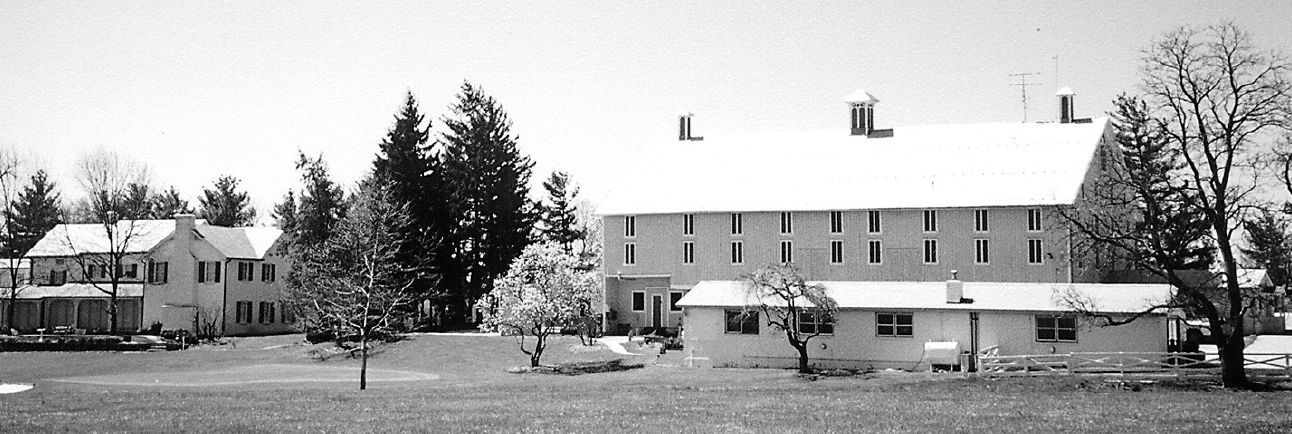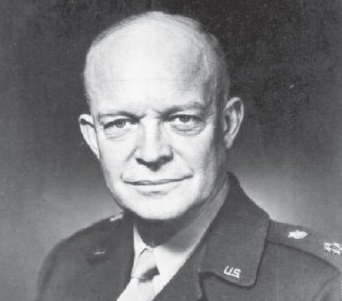Eisenhower at Gettysburg: The Twilight Years
by Diana Loski

The Eisenhower National Historic Site, Gettysburg
(Author photo)
Between the end of the war and his tenure as President, Ike and Mamie realized that they needed a home. Because of his decades traveling with the military, the couple had never owned a home. With Ike’s parents gone, returning to Kansas to live was not an option. Mamie’s father had also passed on, and the couple would welcome her widowed mother wherever they settled.
While visiting their old friends, George and Mary Allen, who owned a farm near Gettysburg, the Eisenhowers decided that the historic town would be a good place to spend their twilight years. “After all,” Ike later wrote, “Gettysburg had been significant in the early years of our married life and our sentimental attachments to it were reinforced by its significance in American, as well as our personal, history.”2
In 1950, the Eisenhowers purchased a farm south of town abutting the Emmitsburg Road and a short distance from the historic Pickett’s Charge field. In 1918, the field had been the site of Camp Colt, the World War I training camp that Ike had commanded. The farm needed restoration, and for several years – during much of Eisenhower’s first term in the White House – the house was almost completely overhauled. It was finished in time for Ike’s second term, where he entertained heads of state, his cabinet, and many political leaders (including future Presidents) at his farm.
It was on Inauguration Day, January 20, 1961, the day John F. Kennedy became the 35th President of the United States, that Ike and Mamie truly faced retirement. They drove from Washington D.C. in their Chrysler Imperial sedan and made the journey to Gettysburg.
The day was bitterly cold and a recent snowstorm had made the roads precarious. In Gettysburg, crowds appeared as the welcoming committee. The following evening, festivities were planned in Lincoln Square. Al Scharf, the owner of The Gettysburg Hotel, was one of the organizers of the fete. “This is the greatest thing to happen to this town since the battle,” he said to his wife. “He is the best-loved President since Lincoln.” 3
Fortunately, Ike and Mamie were eager to become involved in Gettysburg’s local events. Ike took an office near Gettysburg College, where he wrote his memoir, At Ease, and worked on other writing projects. He officiated at significant events, such as the 100th Anniversary commemoration of the Gettysburg Address. Mamie volunteered for the American Heart Association, donated personal items at the opening of the National Apple Museum in Biglerville, and joined the Gettysburg Women’s Club. Ike became a member of the Rotary Club. The couple attended church regularly at the Gettysburg Presbyterian Church. Reverend Bob MacAskill, who was a licensed battlefield guide at Gettysburg as well as the pastor, became friends with the general. “They came regularly when they were in town,” Reverend MacAskill recalled. “They divided their time between Gettysburg, Washington (D.C.) and California. We often discussed the battle.”4
As a military officer of the highest caliber, combined with an interest in history, Ike chose the perfect town for his retirement.
When not occupied with local events, the Eisenhowers spent time with their family. Their only surviving son, John, visited along with his family, especially during the holidays. The Eisenhowers entertained friends nearly every weekend when they were at home. Guests were required to sign a guest book upon entry. Bridge was a favorite game, and they often played it with their visitors.5
The Eisenhowers relished private time on their farm. Ike had taken up painting at the end of the war for a creative outlet. His artistry was good, and his paintings grace the walls of his farm to this day. He also gave away many paintings to his friends and colleagues. He painted landscapes and portraits – one of his portraits was of Abraham Lincoln.6
The Eisenhowers’ favorite room was the enclosed porch, or sunroom, located at the back of the house. Here the couple ate dinner on TV trays and watched television. They spent New Year’s Eve watching Guy Lombardo ring in the next year. Just outside the sunroom was Ike’s putting green. Golf was one of the general’s favorite pastimes. His Gettysburg caddy, Art Kennell, remembered that he “probably spent a thousand hours with him on the golf course. I could always tell how he greeted me whether he had golf or the nation on his mind.” Mr. Kennell, who served for many years as the caretaker of the Evergreen Cemetery, admitted that the former President “had a temper. Sometimes on the golf course the words flowed freely. I guess golf can do that to you.” 7
Ike also raised prize-winning Black Angus cattle on his 190-acre farm. His bulls were continuously in competitions, and they often won – a source of pride and satisfaction for the man from Kansas.
Whether writing, golfing, working the farm or traveling, the Eisenhowers were far from retiring citizens. Mamie was grateful for their time at the farm. She believed it prolonged her husband’s life. She had worried constantly about him during the war, and realized she had to stop fearing the worst. “I had to build a philosophy,” she said, “ which was that nothing was going to happen to [Ike] until God was through with what he had put him on this earth to do.”8
Ike and Mamie enjoyed many years on their Gettysburg farm. The 1960s were a turbulent decade, which would have been unbearable for the general and his wife had they remained in the nation’s capital. The Kennedy assassination, the escalating war in Vietnam, the assassinations of Martin Luther King, Jr. and Robert Kennedy all took their toll on the man who had labored all his life to maintain peace. “ knew the importance of peace ,” said Reverend MacAskill, “ because he had seen war up close.”9
When General Eisenhower finished his personal memoir At Ease in 1967, his heart was again weak, and he had to take multiple periods of rest. When he and Mamie celebrated their 50th Anniversary in July 1966, only family and a few close friends were with them. A large gala was not possible with Ike’s failing health.10
Harrison Harbach, Ike’s Gettysburg physician, explained the general’s condition: “A series of heart attacks formed scar tissue that weakened his heart. Today, the General would have been a prime candidate for a cardiac transplant. Back in those days, we didn’t have that option.”11
In late April, 1968 – the year that would elect Richard Nixon, Ike’s former Vice-President to the White House, Ike suffered another serious heart attack while playing golf in California. He was flown to Walter Reed Medical Center in Washington, D.C. He never returned home to his Gettysburg farm, living the last eleven months in the hospital. He died on March 28, 1969. He was 78 years old.12
From his childhood in Kansas to his final years at Gettysburg, Dwight D. Eisenhower was a man who made every day count. He had studied the past enough to know his life was part of something much greater than he was alone. As one who had the admiration of the free world, he could have lived his retirement among the greatest and wealthiest of his peers. He instead chose a Gettysburg farm as his home, and an already historic town to add to his own pedigree.
Ike was one who loved Gettysburg, because the historic town is one of our nation’s great legacies. And so is he.

Dwight D. Eisenhower (1890-1969)
(Library of Congress)
Sources: Eisenhower, David. Going Home to Glory: A Memoir of Life with Dwight D. Eisenhower, 1961-1969. New York: Simon & Schuster, 2010. Eisenhower, Dwight D. At East: Stories I Tell to Friends. National Park Service: Eastern Acorn Press, 1998 (reprint, first published in 1967). Eisenhower, Susan. Mrs. Ike: Portrait of a Marriage Sterling, VA: Capital Books, 2002 (reprint, first published in 1996). Harrison Harbaugh interview with author, April 16, 1999. Arthur Kennell interview with author, April 9, 1999. Reverend Robert MacAskill interview with author, April 13, 1999. Additional information found at the Eisenhower National Historic Site (hereafter ENHS), Gettysburg.
End Notes:
1. ENHS.
2. Eisenhower, Dwight D., p. 358.
3. Eisenhower, David, p. 4.
4. Eisenhower, David, p. 115. MacAskill, April 13, 1999.
5. Eisenhower, Susan, p. 104. Eisenhower, David, p. 27.
6. Ibid., pp. 64, 112.
7. ENHS. Kennell, Apr. 9, 1999.
8. Eisenhower, Susan, pp. 227-228.
9. MacAskill, Apr. 13, 1999.
10. Eisenhower, David, p. 181.
11. Harbach, Apr. 16, 1999.
12. Eisenhower, David, p. 249. Eisenhower, Susan, p. 311.
Art Kennell, Harrison Harbach and Bob MacAskill have all passed on. For one of the first articles on General Eisenhower, in 1999, the author interviewed these three men, as well as others who knew the former President and First Lady. In addition to these interviews, the author met these good men many times, and is grateful to have had the time with them and to have listened to their memories of Ike. Reverend MacAskill, incidentally, was the pastor who traveled with Ike’s funeral train to Kansas and officiated at the burial at Abilene.

